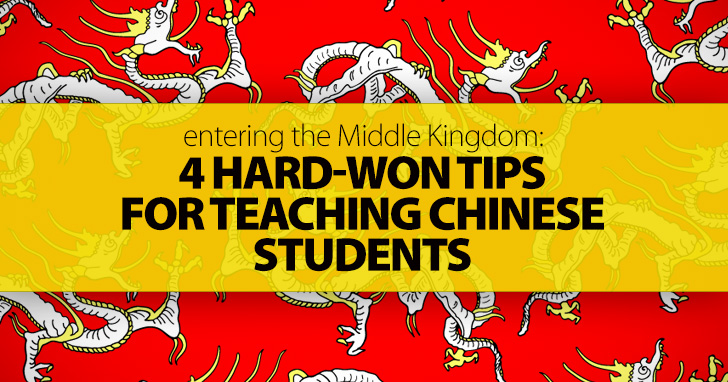When Coffee Talk Is Off the Table: Tips for Communicating with Non-English Speaking Parents


An overseas education is seen by some as a pre-requisite for success, and English has come to play a central role. Huge increases in the number of Chinese students sitting the TOEFL test (up 19% from 2011 to 2012, for example) demonstrate this new emphasis on English, and ESL is now an area of great effort and investment in China. However, important differences between the education systems in China and the west have caused difficult classroom situations for teachers and students alike.

Education in China has long been wrapped up in the country’s complex political life, and for this reason it is often criticized for its focus on rote memorization of facts, its rigid teacher-centered learning model, little focus on critical thinking, and a notoriously strong emphasis on exams, which causes enormous stress among students. As ESL teachers, even those living in China, we must accept that this system is both venerable and highly resistant to change.
At the same time, Chinese students are becoming a major force at universities around the world, with 158,000 attending US colleges in 2010/11, up 25% from the previous year. However, it has been reported that perhaps 25% of Ivy League students from China actually drop out before finishing their degree; the most commonly cited reasons are the language barrier and differences in the style of education.
As a teacher with Voluntary Service Overseas, I was invited by the Chinese Ministry of Education to bring communicative methodology to the language departments of two Chinese universities. Later, I taught all-Chinese classes at a language school in Boston, where I saw first-hand the main reason for such high drop-out rates in the tendency for Chinese students to form insular enclaves in which the language, culture and social life from home can be recreated abroad.
I learned over time that trying to impose change did not produce positive results, but that working within the established structures succeeded better. This meant learning to deal with classroom passivity, empathizing with the students’ passionate devotion to their country, and accepting that they had come through a language learning style which stemmed from traditional methods of learning Chinese.

A number of colleagues have asked for advice on dealing with largely or entirely Chinese classes, and I’ve isolated a few of the main stumbling blocks which Chinese students face. Helping our students to overcome these issues goes a long way to creating a more productive and enjoyable learning environment. So, here’s my breakdown of the main problems Chinese students encounter when adapting to Western-style education. I mean no criticism here, neither of individuals, ethnic groups, political systems nor nationalities; I’m simply identifying consistent and illustrative truisms which I’ve found through my experience with Chinese students.
Anyone who has stood in front of a class of Chinese students will tell you to expect a good deal of silence. Among other things, this stems from:
I trained Chinese undergraduates to become English teachers, and in doing so, I was daily reminded that their principle duty was to impart ‘knowledge’. This word became a mantra, and the dominant causation behind pedagogical decisions. The task was the supply information to the students, and for them to remember it.
I argued that knowing something is different from being able to do it. I provided endless examples: reading every book ever written about Einstein would not make you a great physicist, neither would listening to a thousand hours of classical piano suddenly transform the student into a pianist. In the same way, memorizing great big lists of vocabulary might help somewhat in the limited, multiple-choice world of the exam room, but it was next to useless when it came to expressing yourself in English, or understanding what was being said. Stripped of context, vocabulary became a time-sink with little educational value; the students didn’t know where knowledge ended and skills began.
Any language learner sees L2 through the lens of L1. We superimpose the structures and idioms of our own language onto that which we’re studying. Chinese students do this in a comprehensive fashion, translating word-for-word and thereby producing fractured, ungrammatical English. As “Chinglish” spreads, its habits ossify and become standard practice in the classroom. Here are two real examples from an intermediate-level, all-Chinese class I taught recently:
| Teacher: | Morning, everyone! How was your weekend? |
| Students: | Good / Boring / Weekend? [One student had either forgotten he’d had a weekend, or forgotten the word. I’m not sure.] |
| Teacher: | OK, how was yours, Lilly? |
| Student 1: | Bad. |
| Teacher: | [Waits patiently.] |
| Student 1: | Very bad. |
| Teacher: | And why was it so bad, Lilly? |
| Student 1: | I was boring. |
| Teacher: | [Spotting a grammar opportunity.] Is that really what Lilly means, guys? |
| Student 2: | Weekend was boring. |
| Teacher: | Whose? |
| Student 2: | Huh? |
| Teacher: | Whose weekend was boring? |
| Student 2: | Lilly. |
| Teacher: | Well, what did you do, Lilly? |
| Student 1: | Sleep. |
***
| Teacher: | OK, let’s talk about practice for today. What do you need to practice before Monday? |
| Students: | [Mumbling a bit.] |
| Teacher: | Think about it, guys. There was a bunch of new vocab from today, right? |
| Student 1: | Vocabulary... need to practice? |
| Teacher: | Oh yes. It’s very important. How are you going to practice it? |
| Student 2: | Repeat. |
| Teacher: | Sorry? |
| Student 2: | Repeat vocabulary. |
| Teacher: | There might be a better way than just repeating. |
| Student 3: | Just remember. |
| Teacher: | I’ve got a crazy idea. How about practicing in sentences? |
| Student 4: | Too much time. |
| Teacher: | You have too much time? |
| Student 3: | No, he mean, sentence is too many time. Too lazy. |
***
Earlier in their education, my students had established that short, ungrammatical utterances were probably sufficient, and then progressed no further. This is what is meant by the ‘spread’ of the ‘Chinglish disease’. It is highly contagious, and the only way to prevent its spread is to eradicate it on first contact. I really, really tried:
| Teacher: | So, I want to talk a bit about video games today. What do you think? |
| Student 1: | Games! |
| Teacher: | Who plays video games? |
| Students: | [Almost every hand is raised.] |
| Teacher: | How often do you play, Edward? |
| Students: | [Every other hand drops, as the students realize they’re going to be called on.] |
| Student 2: | Hmm. Maybe two hour. |
| Teacher: | Two hours a day, do you mean? |
| Student 2: | Hmm. |
| Teacher: | So, how often do you play games? |
| Student 2: | Huh? Already. |
| Teacher: | Yeah, I know. I just love a full sentence, you know me by now. |
| Student 2: | I play game... every two hour. |
| Student 3: | [Chastises his classmate in Chinese and corrects him.] Two hours a day. |
| Teacher: | OK, we’re getting there. Everyone, how often does Edward play games? |
| Students: | Two hours a day / Two hours every day |
| Teacher: | How often do you play games, Edward? |
| Student 2: | I play game two hours a day. |
| Teacher: | OK, that’s a bit better. See? It’s easy, isn’t it? Now, what about you, Gary? |

While these problems can seem insurmountable, there are steps you can take to ensure a more successful classroom experience.
I can’t stress enough the importance of introducing tactics which mitigate against these problems on your very first day with the class. It is much easier to deal with L1, or direct-translation “Chinglish” language early on, otherwise your semester might well be spent trying to pull words out of reluctant, mono-syllabic students who don’t see why you’re doing so.
I’ve written about this elsewhere, so to be brief: set up a system of rewards (points, games, a movie, chocolate) and modest sanctions (making the student sing or dance, painting their nose with the whiteboard marker, setting an extra quiz) which pressures the students to use not a word of Chinese throughout all of their classes. Do whatever you can to encourage use of English outside the classroom: help the students make friends with non-Chinese speakers; give extra credit for watching movies in English; get cheap copies of popular novels in English and hand them out; ask the students to listen to a particular radio news program every day.
Once you’ve extracted a full sentence from a student, gleefully seize on this as an example of the Holy of Holies – idiomatic, non-Chinglish production which did not rely on a translation. Then set up a series of short hand gestures so that you can easily indicate to your student when the sentence is too short, or incomplete. I use an expanding hand gesture to encourage fuller answers, and frown glumly upon, or growl menacingly at, choppy, one-word responses. Another nice gesture is the whirling circle of a hand-cranked engine starter, winding up the student until they achieve ‘ignition’ and produce the full structure you’ve been looking forward to.
Making light of these difficult issues is very useful. Visual humor works best with lower-level learners – not incidentally, a lot of classic Chinese humor is of the ‘slapstick’ variety – and laughter reduces stress levels. This also makes an important point: producing a full sentence takes some planning, so the students should begin that process quickly, and make it their standard approach.
I set vocab practice homework every single class and require the students to show me at the beginning of the next class. Our homework routine is:
Many countries have complicated political and diplomatic histories. If you’ve traveled abroad, you may well have been quizzed as to why the US and UK invaded Iraq, for example. China is no different, and it is important for us to remember this, particularly when dealing with younger learners.
Some foreign teachers in China have viewed their classes as an opportunity to discuss human rights. Though important and worthwhile, these discussions too often come across as implicit criticism of China’s government and people. Raising the lack of genuine elections in China, for example, may well be seen as an attack on a political system which, albeit imperfect and controversial, has brought millions out of poverty since 1949.
Developing a relationship with Chinese groups can be tricky. As well as creating a fun, active environment and building a positive rapport, we must always be careful not to antagonize or discourage students who possess a rare miscellany of ‘red buttons’. Aspects of politics, history and China’s relations with her neighbors are extremely sensitive; I once found myself being required to apologize in front of 400 Chinese students for Britain’s part in the Opium Wars of the mid-19th century, and the seizure of Hong Kong in 1842. This showed the depth of feeling relating to incidents in which China was humbled; modern China’s commitment to territorial integrity, and the tone of her government’s relations with its neighbors, stem from a fear of experiencing such humiliation again.
I would advise you to avoid these topics, even if the students bring them up: